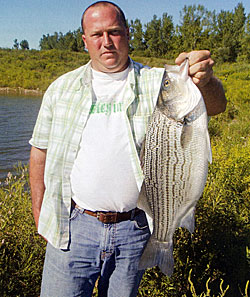
You've been reading about them. You may have even stocked and raised a few of them. But, what is a hybrid striper, really?
A hybrid striped bass is truly a hybrid, a cross between two different species offish, the striped bass Morone saxatilis and the white bass, Morone chrysops. The primary, most commercially available fish is the cross between female stripers and male white bass. This cross is colloquially called hybrid in much of the United States, but also wiper in the Midwest. Early on it was given the nickname of Palmetto bass. Some of the older fish squeezers still call it that, but I don't hear it very often.
Here's how it works. Each spring, at just the right time, the fish hatchery collects mature, ripe female striped bass and strips their eggs, usually by squeezing laterally from the front of the fish on both sides, downward to the vent. It's not unusual, for the sake of timing and uniform egg collection, to inject the females with a natural hormone to help their eggs mature uniformly for a few days before stripping them. Stripers grow much larger than white bass, so female striped bass subsequently have a lot more eggs than their white bass counterparts. It's not unusual for eggs to naturally mature in the ovaries even a few hours apart, but when it's time to collect the eggs in a hatchery environment, technicians want as high a success rate as they can get. They want all the eggs to mature at the same time, if possible. That's a part of the reason for the injections. When ready, eggs are collected from the female and then immediately fertilized with milt from a male white bass.
Eggs are put into a tall, cylindrical device called a McDonald Jar, which provides a specific rate of current from bottom to top and maintains a precise temperature. Inside that jar, the eggs are semi-buoyant, not floating nor sinking. After about 48 hours, the eggs start to hatch and the fry move to the top of the jar, where they flow over the lip of the jar and into a tank where they are collected.
At that point, they are so small all you can see are a couple of black dots, their eyes. When a baby fish is hatched it has no stores of energy, and with tiny mouths, they need the best nutrition as soon as possible. For the next five days, the little fish can live off what used to be the yolk of its egg. Fry are siphoned off and numbers are estimated by volume and then stocked into prepared hatchery ponds. Timing is huge here. When the fry hatch, the growing ponds must have exactly what hundreds of thousands of tiny fish need to eat, immediately. From here, the husbandry is proprietary. Some tales are spun about using special mixes of oil with protein additives, but I don't know the recipe for Coca Cola, either. Ultimately, the small fish are feed-trained by hatchery personnel to increase production, since the hatchery is also in business to make a living. The world's largest producer, Keo Fish Farm, east of Little Rock, Arkansas, literally cranks out millions of fry and fingerlings each year and has since the mid-1980's. They've figured out what it takes to get the best survival possible from their fry. Odds are almost 100% that if you've bought hybrid striped bass to stock a pond or lake they originated at Keo.
One of the most interesting facts about hybrid stripers is they are well adjusted to pond situations, unlike either of their parent species. They can tolerate ranging temperatures and lower oxygen concentrations than either parent. Those are key reasons they might be a good candidate to stock your waters. That, and the fact they'll readily eat high quality fish food.
For the sake of knowledge, there are small numbers of the reciprocal hybrid, the cross between female white bass and male stripers. Those are called Sunshine bass in the industry. These fish are usually produced in agency fish hatcheries around the nation.
After fry are grown into fingerlings, other hatcheries buy them to raise. Some grow them for the food fish market and others tap into the sport fish market.
Debbie loves them because they are silver and pretty and swim really fast. I like them because it's almost like a locomotive slams your bait when you are fishing for them. We both enjoy them because they make mighty fine table fare, too.
From a fisheries standpoint, one of the reasons for their rising popularity is they fit into an often unused niche on people's ponds and lakes, the open water areas where largemouth bass typically don't often venture.
Oh, and they don't reproduce. That's one of the benefits of this true hybrid. You can stock them for any of a plethora of reasons and have total control of their numbers.
Makes me want to run up to our north hatchery pond, catch a few and fillet those gorgeous silver streaks.
Reprinted with permission from Pond Boss Magazine


